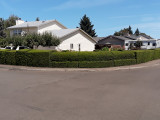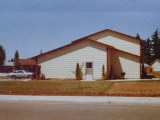It hasn’t traveled a single mile—but people have come from miles to see it.
YOU CAN’T MISS John and Annette Bemis’ house. Theirs is the one with the hedge neatly shaped into a 150-foot multi-car train that stretches around the corner lot. It’s a Canby, Oregon, landmark John Bemis planted and has grown, sculpted and tended since 1978.
“When we purchased our home, my first thought was that the corner was perfect for a train, so I planted one,” Bemis says. “It took three years before it was big enough to trim, but over the years, my train has caught the eyes of many people.”
Bemis, who retired from shipbuilding as a member of Local 72 (Portland, Oregon, now consolidated into L-104, Seattle) has just always liked trains. He grew up in a train town: Wellsville, Ohio, a little west of Pittsburgh, where he admired the town’s large roundhouse and the steam engines that ran up and down the Ohio River.
“I would always hear the whistles blow, and it just became fascinating,” he says. The idea for a hedge train took root in his mind’s eye when, as a young adult on a Church of Jesus Christ of Latter-Day Saints mission trip to Uruguay, he spotted a hedge shaped into a circus train, complete with animals. It made an impression on him, and an idea was born.
Fast-forward a few years as John and Annette Bemis prepared to move into their then-new house in a then-new housing development: The lot was a dirt, barren, blank slate. The perfect place to bring his topiary train vision to life.
“We planted these little bushes—only 12 to 18 inches high and 12 inches apart. People asked what I was doing, and I told them I was making a train,” Bemis recalls. “They thought I was drunk or crazy!”
People tell me it was their favorite thing growing up, and they always come by to see it when they’re in town. A lot of people remember it—it’s kind of a landmark.
And what did Annette Bemis think about it? “I was all for it; but, let me tell you those sticks looked pretty bad for a while,” she laughs.
But her husband, who had years earlier taken botany classes, had sketched out his plan; and after three years, the hedge was ready for transformation. It’s grown and delighted neighbors and visitors ever since.
“I always get a lot of people coming by and giving me a thumbs-up. They’re excited to see it,” Bemis says, noting he’s heard comments from as far away as Texas, due to newswire pick-ups from local press coverage. “People tell me it was their favorite thing growing up, and they always come by to see it when they’re in town. A lot of people remember it—it’s kind of a landmark.”
To add to the experience, Bemis even bought a whistle that mimics real-deal trains. He blows the whistle near the hedge when kids go by (but admits he enjoys entertaining the adults just as much).
Over the years, the hedge has sometimes taken a beating, from the five Bemis boys and their friends’ backyard activities—soccer balls kicked through, kids attempting to hurdle over it and the like—to, most recently, vandalism. But it’s always grown and been shaped back.
“Mother Nature is very forgiving,” Bemis says. “If you cut too deep or a soccer ball makes a hole, you give it time and it eventually grows back. Nature is nice that way.”
Caring for and shaping the train hedge to look its best has also helped Bemis look and feel his best. During the summer when the hedge is in active growth (it’s an Amur River Privet Hedge, by the way), he has to trim it about every 10 days, which is a four-hour job each time from cut to cleanup.
“It’s a good source of exercise—lots of deep knee bends and shoulder movements,” he says. In four decades, he’s gone through about five trimmers—the last two have been professional grade. “My wife and I debate what to do, because the hedge is getting bigger, and I’m getting smaller. I keep threatening to put a fence in, but she says ‘no.’”
“I’m it’s biggest defender,” Annette Bemis agrees. “Too many people love it.”
Adds John Bemis: “Today it’s 41 years old, and it hasn’t traveled a single mile—but people have come from miles to see it.”









